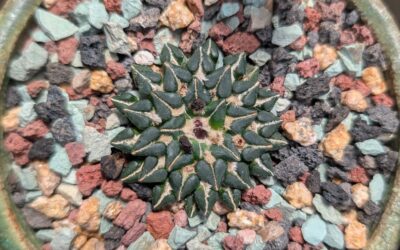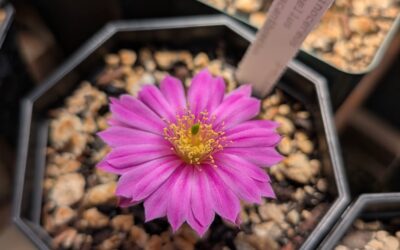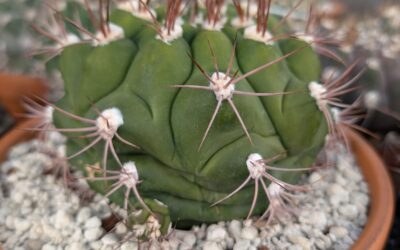Preparing for Winter – Yes, It Gets Cold in San Diego
Based on my Instagram feed, most of the US started preparing their plants for winter a couple months ago. The main indicator that it’s time to start winter prep is when the nights turn cold – once temperatures start dipping below 50F at night, that’s a pretty clear indicator that it’s time to set your cacti up for winter weather. We only just hit those temperatures in the last few weeks, and I began setting up my cacti and succulents for a San Diego winter. I’ll focus on just the cacti for this post.
I have three main groups of cacti I set up for winter weather: potted and not cold hardy, potted and cold hardy, and in-ground.
I define cold hardy vs not cold hardy based on whether they can tolerate frosts, and how dry their roots need to be for weather below 50F. This year will be my first winter with a handful of species that truly need a dry winter while they are dormant for cold temperatures, and I don’t have a large greenhouse structure to house my plants. Last winter, I brought in my handful of sensitive cacti or succulents when I thought it might rain, but it could be hit or miss and I lost several to rot.
Interestingly, the cacti I have in the ground all did well last winter, even though many are species where care directions suggest to keep them quite dry when it’s cold. There are a couple of things I do to prepare my cacti for cold, rainy weather, and I’ll cover what I did last year and this year in that section.
Ironically Easy: The Cacti That Hate Cold and Wet
For copiapoas, ariocarpus, or lophophoras, you need to keep them very dry when the nights are cold. Most of what I’ve read online about astrophytum, gymnocalycium, or any of the smaller, globular cacti species is to keep them quite dry over winter to guard against root rot. This is my first winter with copiapoas and ariocarpus, and I’ve moved them into my little Amazon greenhouse. It’s flimsy and the poles are rusting out, but it’s sheltering the plants and keeping them dry (and warm) so it’s working until I can get a more permanent greenhouse structure built.
Being in San Diego means that we don’t get hard frosts the way folks further north do, and we can count nights below 30F on one hand each season. Because of this, I have no plans to heat my greenhouse, nor do I expect to be doing anything for the potted cacti to keep temperatures higher. We actually get periods of warm weather even in winter, such as this week in November that’s ranging from the mid 80s into the 90s! These warm spells mean I’ll monitor my cacti and may carefully water them if there’s likely to be two or three warm days in a row.
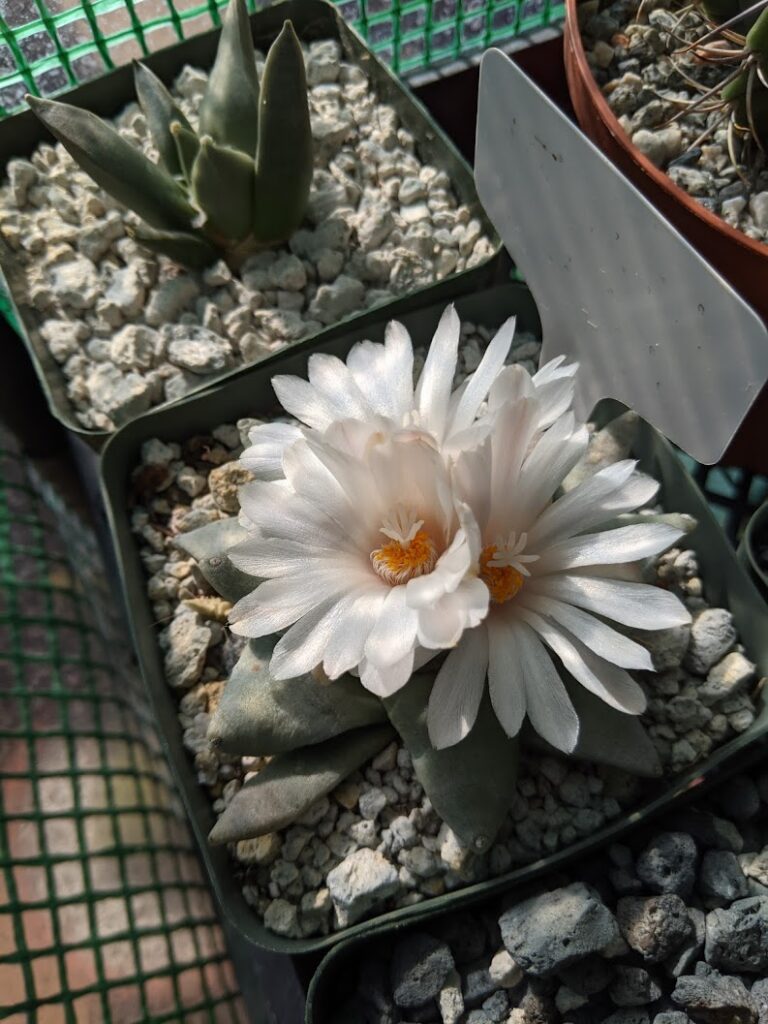
Very happy Ariocarpus retusus in full bloom after being protected from a bout of late fall rain.
When I water these cacti for cooler weather, I don’t do the full thorough watering I would during summer. In cooler weather (and in general to protect the fluff on my fuzzy cacti), I use a condiment bottle with a little application nozzle so I can place just a small amount of water over the top of the soil. This is enough to prevent the cacti from drying out completely, but ensures their roots don’t stay soggy when cooler nights roll back in. I also pot the species that need to be kept pretty dry in a nearly soilless blend, made up most of pumice mixed with a small amount of quality cactus/succulent soil. The ariocarpus and copiapoas are in about 75% pumice and 25% soil, aside from a handful I’m trying with a north american cactus blend from a seller on Instagram. That blend is entirely inorganic, meaning it’s nothing but rocks – we’ll see how the cacti do. So far, compared to the pumice blend, I’m not seeing anything life changing, but the growth is still good to see.
I also shift from the heavy, plant-body-covering watering method I use in summer to ensure maximum water absorption, and only apply water on the surface of the soil or potting medium. Again, the goal is to give them just enough water so they don’t shrivel up and die. I don’t want the roots to be too damp while temperatures at night are low, as the cacti are pretty much dormant and not metabolizing water at the same rate as summer.
The Hardy Potted Cacti: They’ll Put Up With It
Most of the cacti I’ve kept for the last few years have been species that tolerate being outdoors, unprotected, and semi-abused by rain, hail, and cold weather. Felicia, my beloved Pilosocereus pachycladus (purchased as Pilosocereus azureus), is one such cactus. This year, I planted her in the ground, but for the last 4 or 5 winters before that, she was just in a pot on the patio being exposed to the elements. Our property only gets actual frost on a couple of slopes, so the patio was sheltered enough that the brazilian species was able to thrive and reach over 5 feet tall in just a year or two.
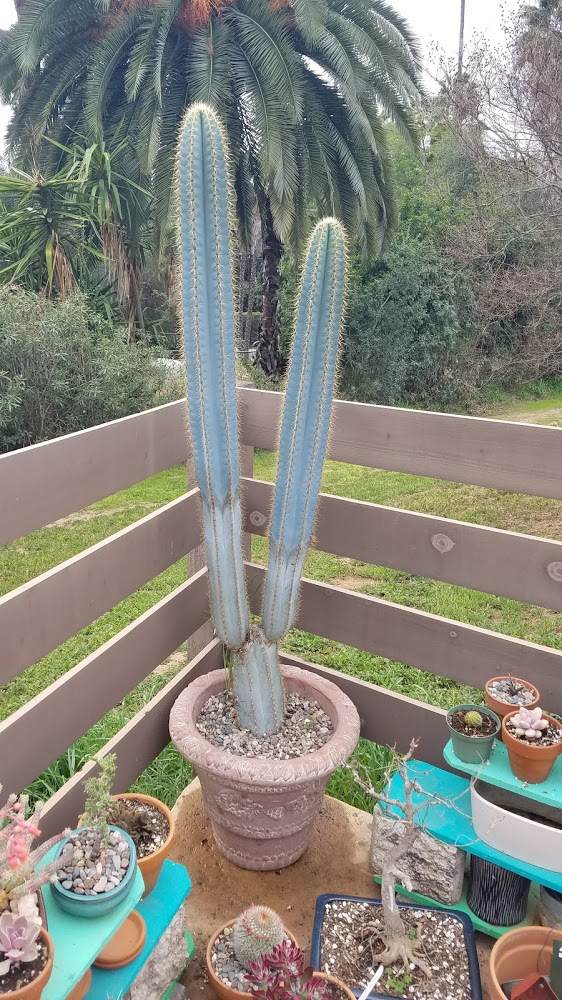
Felicia the cactus – all that darker blue growth was from a single growing season.
My gymnocalyciums, tephrocactus, opuntias, and pretty much everything else all stay outside in the elements year round. I have a few younger ferocactus that I keep in pots until they’re a large enough size that I’m comfortable sticking them in the ground, along with several other genus.
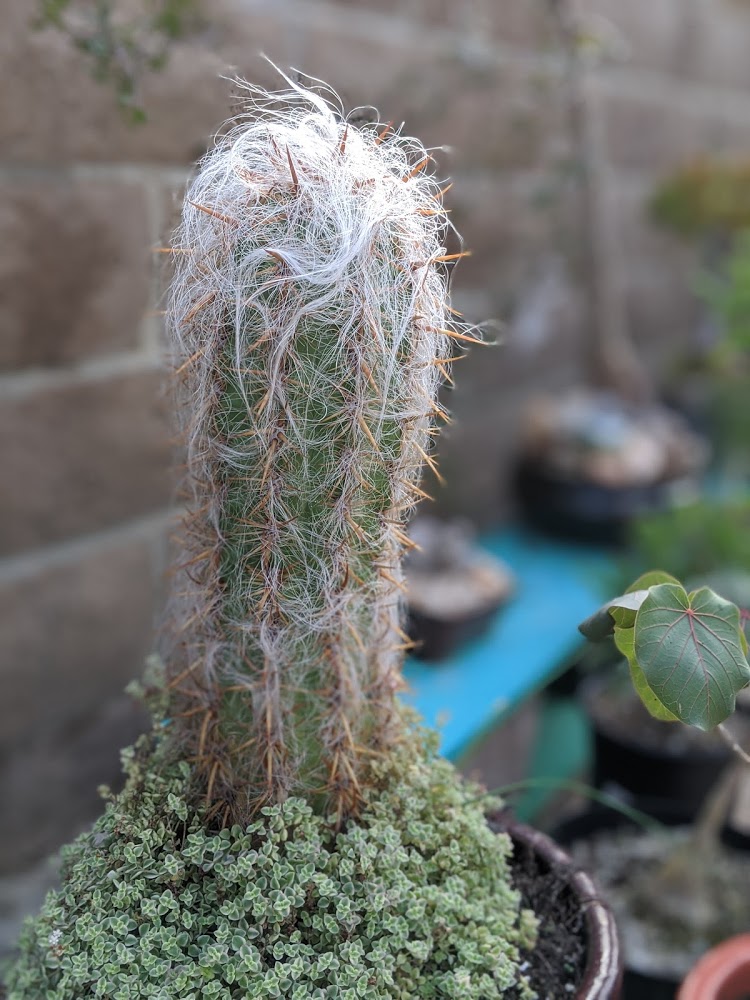
Old Man of the Andes in a mixed planting; he looks best in winter when the little variegated sedum is in full creeping growth
While too much rain for too long will rot them out (my mammillaria plumosa was one such casualty), by mixing in additional perlite or pumice into the soil, my potted cacti generally dry out within a few days of heavy rain. If we get a prolonged period of rain and cold, as we did in the spring of 2020, that’s when things can get touch and go. I frequently see rust on a handful of cacti, and it’s by late winter/early spring that I see plants rotting out. I’m willing to accept those casualties, although this year should be the last year I have to do so thanks to installing an actual greenhouse structure.
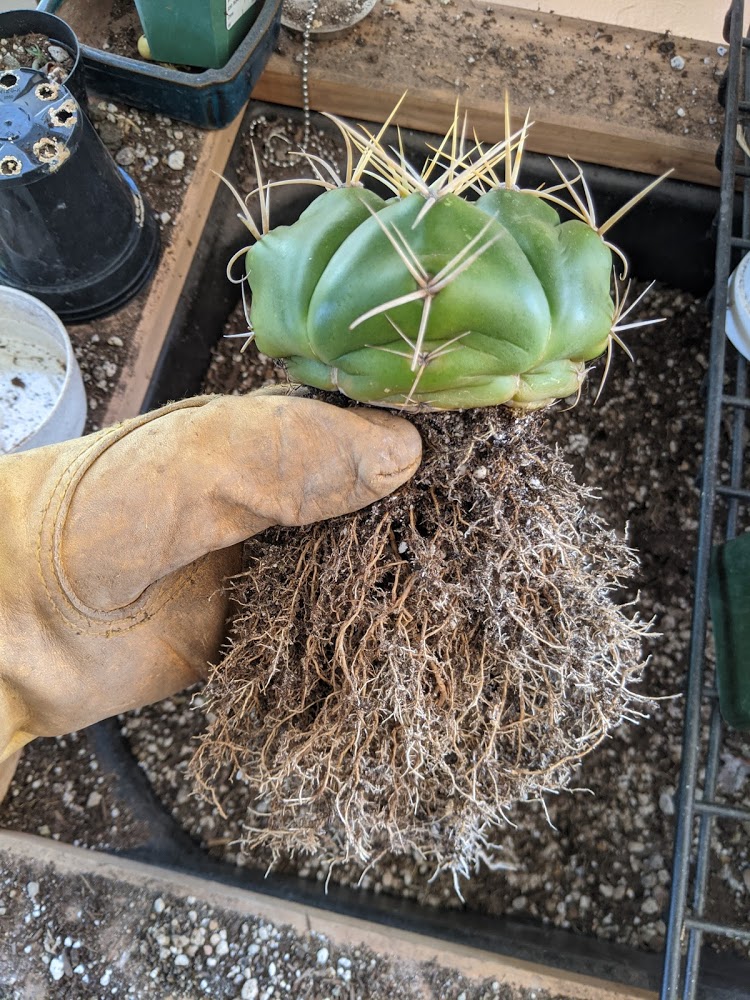
Gymnocalycium horstii being repotted this year; potted in a high-pumice mix and being exposed to the elements for several years shows some pretty substantial and happy root growth
Our weather here bounces back and forth quite a bit, so while I normally scale watering back significantly for these cacti, I often still water these cacti even through winter. This is especially true with our warm spells, where we have days or even weeks with daytime highs in the 80s and even 90s. I water much less during winter months, using a condiment squeeze bottle to just moisten the top bit of the soil, which helps make sure the roots aren’t overly wet when nights drop down into the 30s or 40s on clear nights.
Otherwise, my hardier potted cacti just get to sit out in the elements, get watered when I remember, and just…left to their own devices.
Varying In-Ground Cacti Care
I have two ways that I care for the cacti here that are in the ground: my delicate babies, and the ones that were here before we moved in.
The ones that were here before we moved in are in our backyard, on a very slanted slope, and prior to me, got no supplemental water as far as we know. These cacti generally get very sad in summer, and very plump in winter, with a handful of them actually absorbing enough water that they split. These large, abused cacti include our Peruvian Apple Cactus, a massive Opuntia that is probably an Opuntia consolea rubescens, a couple of other opuntias, several types of echinocactus, and multiple clusters of cleistocactus. None of these cacti look as great as they would if they were watered consistently or maintained a bit better, but until I get around to landscaping that back area, they’ll just keep living the hard life.
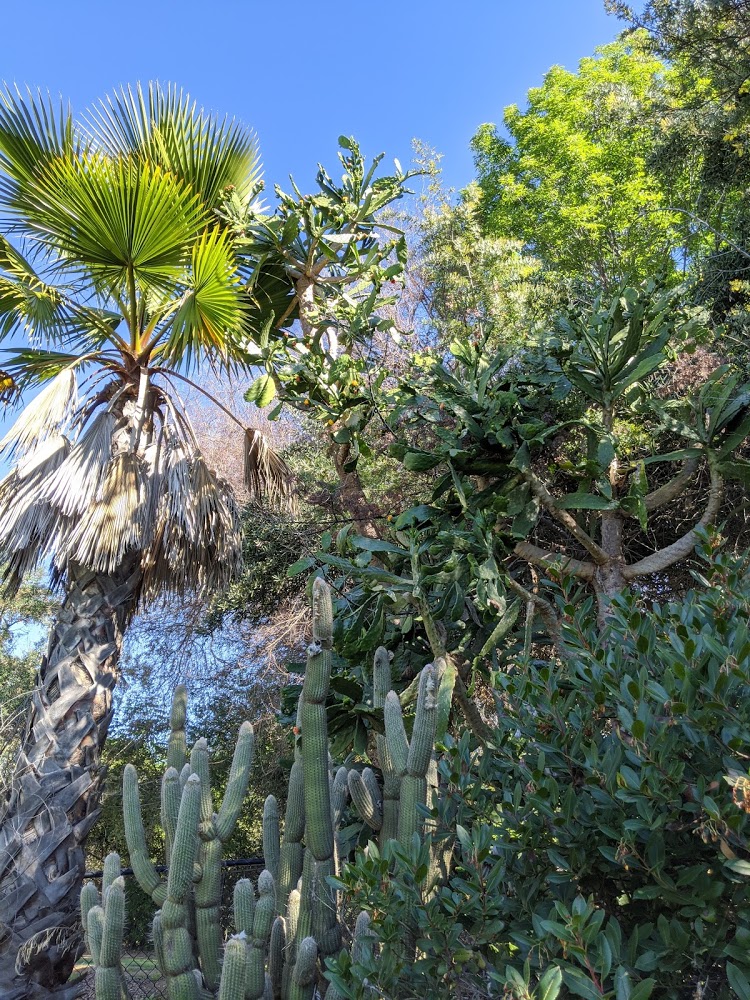
At the far left is a 20 foot tall palm tree, with a …cleistocactus of some kind? and behind it our ginormous opuntia, which is likely a “road kill opuntia”, stretching above the top of the palm tree.
While the cacti in the backyard generally seem to do fine with some benign neglect, out front are my younger or newly planted cacti that generally need a little bit of winter prep. I’ve been making sure to mulch over where things are planted, which acts as a bit of insulation as their area gets cold enough for a light frost, as well as provides a weed barrier for our never-ending weed problem. We also have pretty sandy, rocky soil with a lot of clay, so it takes a long time to really absorb moisture, the water doesn’t typically absorb very far down, and it can have issues with drainage. Mulch helps with this, as a nice thick layer of untreated bark mulch slowly decomposes, which adds nutrients to the soil and helps it to be less compacted and dense.
I’m not terribly picky about the type of mulch used, and we’ve been able to get eucalyptus mulch easily from trees being trimmed on our property, as well as pepper tree, pine tree, oak tree, etc. I would not be able to use this type of mulch in other scenarios (such as for my reptiles), but it’s perfect in this case.
I have a lot of cacti and agave out front, as the light frost doesn’t bother the majority of my agave speces.
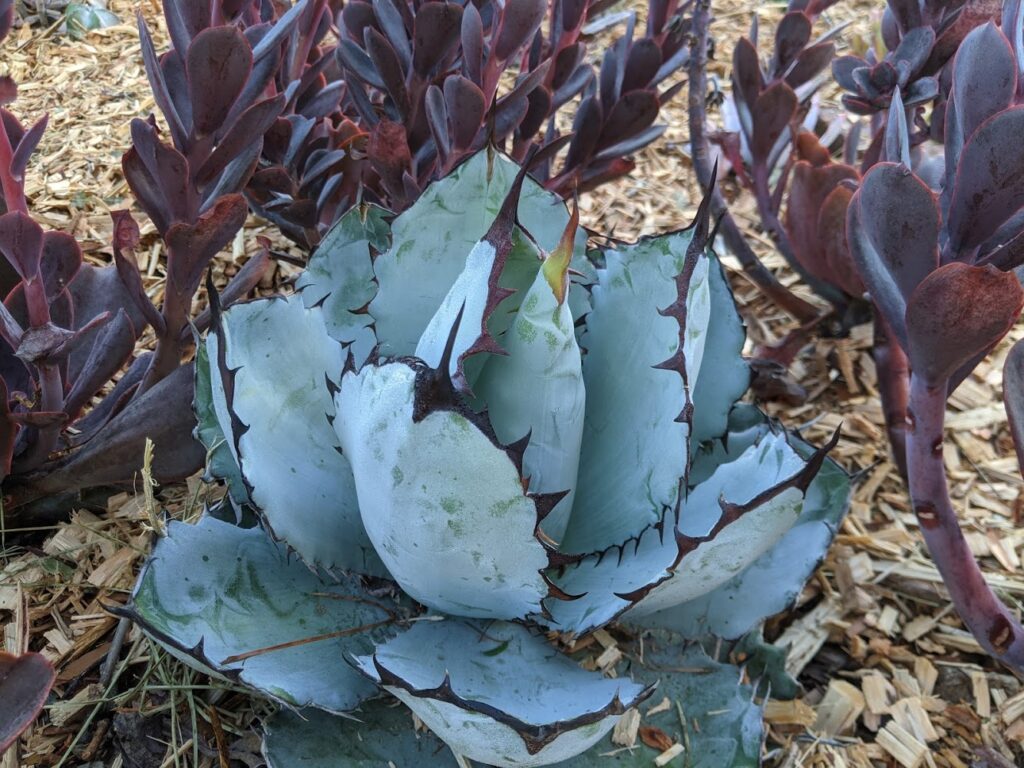
This is one of my gorgeous Agave titanota “Black and Blue” against a backdrop of happily blooming Echeveria hortencia
Eventually, we’ll landscape the front area and I’ll have a nice ground cover of decomposed granite and rocks, but in the meantime fresh mulch does the trick. This time of year, with cooler nights and fog regularly rolling in, the outdoor plants all get a light coating of dew, visible on the agave pictured above. This dew means that my watering schedule can get quite sparse, as most cacti are going dormant and are getting the moisture they need from that dew. I shift from watering the entire area with a sprinkler to using the hose, and focusing on ensuring the succulents get regularly watered as they enter their prime growing and showing season.
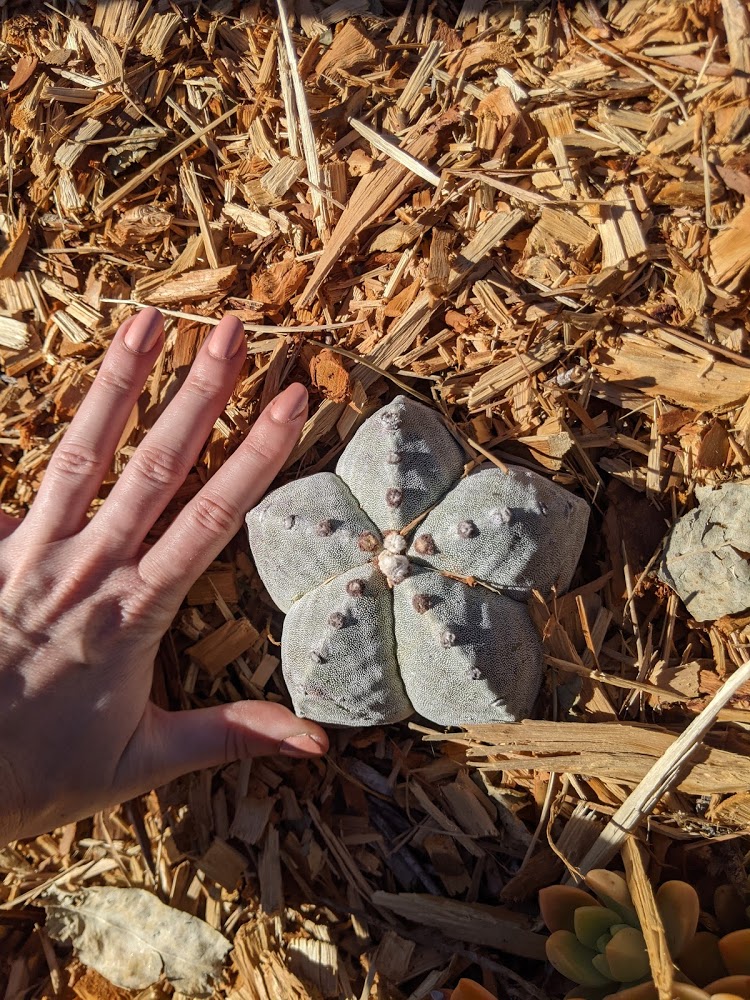
My first Astrophytum myriostigma in-ground, all cozy for winter with mulch. Hand to give you a sense of size!
I’ve so far been able to grow two types of Astrophytum in our front “cactus garden”, including my Astrophytum ornata and Astrophytum myriostigma. This will be my second in-ground winter for both species, and I just added some Astrophytum capricorne to the club, although those are planted in a different area that has a much harder time retaining water, and tends to be much hotter all summer long (somthing the capricornes LOVED this year).
The key overall to growing the cacti outdoors through winter in our area is generally managing moisture. For small collections, bringing them indoors during periods when rain is expected can be manageable, but as soon as you start getting into the area of having 5 to 10 plants that need protection from any winter wet at all, it’s time to look into a greenhouse or shelter of some kind. As a complement to moisture management, temperatures matter as well – the wetter the cactus, the less cold tolerant they tend to be. Here in San Diego, active rainfall usually equates to relatively warmer nights; clouds keep heat trapped in, so while the daytime highs remain low (high 50s, sometimes up into the high 60s), night time lows are generally higher (high 40s, usually low 50s). The biggest challenge is usually how quickly the soil of unprotected cacti can dry out before the clouds clear up. Clear nights are cold nights, so if we go immediately from rainy weather to cold and clear, that’s when I generally can expect issues.
A final San Diego caveat – we also get mild heat waves, even in winter! I can’t remember a single winter that didn’t have at least a couple weeks of 80F weather, with a couple years even having freak heat waves of 90 or 100 for a day or two! These super hot days are risky, as the high heat and intense sun can potentially burn plants, but the weather drying out the soil is immensely helpful. It also poses a challenge in the form of how long it lasts. If the hot weather lasts for a week or more, but the nights still get cold, I have to weigh if the hot days are hot enough to warrant a quick morning sprinkle for the plants that would like more moisture. When it comes to cacti, this answer is generally no, but the succulents require more monitoring.
What is winter like in your area? Share your winter prep with me on Instagram or Facebook!

